Tantalum
 | |||||||||||||||||||||||||||||||||||||||||||||||||||||
| Tantalum | |||||||||||||||||||||||||||||||||||||||||||||||||||||
|---|---|---|---|---|---|---|---|---|---|---|---|---|---|---|---|---|---|---|---|---|---|---|---|---|---|---|---|---|---|---|---|---|---|---|---|---|---|---|---|---|---|---|---|---|---|---|---|---|---|---|---|---|---|
| Pronunciation | /ˈtæntələm/ | ||||||||||||||||||||||||||||||||||||||||||||||||||||
| Appearance | gray blue | ||||||||||||||||||||||||||||||||||||||||||||||||||||
| Standard atomic weight Ar°(Ta) | |||||||||||||||||||||||||||||||||||||||||||||||||||||
| Tantalum in the periodic table | |||||||||||||||||||||||||||||||||||||||||||||||||||||
| |||||||||||||||||||||||||||||||||||||||||||||||||||||
kJ/mol | |||||||||||||||||||||||||||||||||||||||||||||||||||||
| Heat of vaporization | 753 kJ/mol | ||||||||||||||||||||||||||||||||||||||||||||||||||||
| Molar heat capacity | 25.36 J/(mol·K) | ||||||||||||||||||||||||||||||||||||||||||||||||||||
Vapor pressure
| |||||||||||||||||||||||||||||||||||||||||||||||||||||
| Atomic properties | |||||||||||||||||||||||||||||||||||||||||||||||||||||
Discovery | Anders Gustaf Ekeberg (1802) | ||||||||||||||||||||||||||||||||||||||||||||||||||||
| Recognized as a distinct element by | Heinrich Rose (1844) | ||||||||||||||||||||||||||||||||||||||||||||||||||||
| Isotopes of tantalum | |||||||||||||||||||||||||||||||||||||||||||||||||||||
| |||||||||||||||||||||||||||||||||||||||||||||||||||||
Tantalum is a
The chemical inertness and very high melting point of tantalum make it valuable for laboratory and industrial equipment such as reaction vessels and vacuum furnaces. It is used in tantalum capacitors for electronic equipment such as computers. It is being investigated for use as a material for high-quality superconducting resonators in quantum processors.[8][9] Tantalum is considered a technology-critical element by the European Commission.[10]
History
Tantalum was discovered in Sweden in 1802 by
The differences between tantalum and niobium were demonstrated unequivocally in 1864 by
The name tantalum was derived from the name of the mythological Tantalus, the father of Niobe in Greek mythology. In the story, he had been punished after death by being condemned to stand knee-deep in water with perfect fruit growing above his head, both of which eternally tantalized him. (If he bent to drink the water, it drained below the level he could reach, and if he reached for the fruit, the branches moved out of his grasp.)[23] Anders Ekeberg wrote "This metal I call tantalum ... partly in allusion to its incapacity, when immersed in acid, to absorb any and be saturated."[24]
For decades, the commercial technology for separating tantalum from niobium involved the
Characteristics
Physical properties
Tantalum is dark (blue-gray),[25] dense, ductile, very hard, easily fabricated, and highly conductive of heat and electricity. The metal is highly resistant to corrosion by acids: at temperatures below 150 °C tantalum is almost completely immune to attack by the normally aggressive aqua regia. It can be dissolved with hydrofluoric acid or acidic solutions containing the fluoride ion and sulfur trioxide, as well as with molten potassium hydroxide. Tantalum's high melting point of 3017 °C (boiling point 5458 °C) is exceeded among the elements only by tungsten, rhenium and osmium for metals, and carbon.
Tantalum exists in two crystalline phases, alpha and beta. The alpha phase is stable at all temperatures up to the melting point and has
Isotopes
Natural tantalum consists of two stable
Tantalum has been examined theoretically as a "salting" material for nuclear weapons (cobalt is the better-known hypothetical salting material). An external shell of 181Ta would be irradiated by the intensive high-energy neutron flux from a hypothetical exploding nuclear weapon. This would transmute the tantalum into the radioactive isotope 182Ta, which has a half-life of 114.4 days and produces gamma rays with approximately 1.12 million electron-volts (MeV) of energy apiece, which would significantly increase the radioactivity of the nuclear fallout from the explosion for several months. Such "salted" weapons have never been built or tested, as far as is publicly known, and certainly never used as weapons.[30]
Tantalum can be used as a target material for accelerated proton beams for the production of various short-lived isotopes including 8Li, 80Rb, and 160Yb.[31]
Chemical compounds
Tantalum forms compounds in oxidation states −III to +V. Most commonly encountered are oxides of Ta(V), which includes all minerals. The chemical properties of Ta and Nb are very similar. In aqueous media, Ta only exhibit the +V oxidation state. Like niobium, tantalum is barely soluble in dilute solutions of hydrochloric, sulfuric, nitric and phosphoric acids due to the precipitation of hydrous Ta(V) oxide.[32] In basic media, Ta can be solubilized due to the formation of polyoxotantalate species.[33]
Oxides, nitrides, carbides, sulfides
Tantalates, compounds containing [TaO4]3− or [TaO3]− are numerous. Lithium tantalate (LiTaO3) adopts a perovskite structure. Lanthanum tantalate (LaTaO4) contains isolated TaO3−
4 tetrahedra.[35]
As in the cases of other
The best studied chalcogenide is TaS2, a layered
Halides
Tantalum halides span the oxidation states of +5, +4, and +3.
Organotantalum compounds
Organotantalum compounds include pentamethyltantalum, mixed alkyltantalum chlorides, alkyltantalum hydrides, alkylidene complexes as well as cyclopentadienyl derivatives of the same.[38][39] Diverse salts and substituted derivatives are known for the hexacarbonyl [Ta(CO)6]− and related isocyanides.

Occurrence
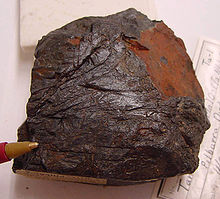
Tantalum is estimated to make up about 1
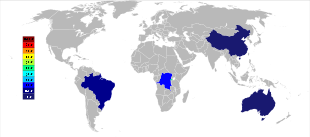
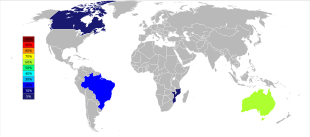
World tantalum mine production has undergone an important geographic shift since the start of the 21st century when production was predominantly from Australia and Brazil. Beginning in 2007 and through 2014, the major sources of tantalum production from mines dramatically shifted to the Democratic Republic of the Congo, Rwanda, and some other African countries.[46] Future sources of supply of tantalum, in order of estimated size, are being explored in Saudi Arabia, Egypt, Greenland, China, Mozambique, Canada, Australia, the United States, Finland, and Brazil.[47][48]
Status as a conflict resource
Tantalum is considered a
Production and fabrication

Several steps are involved in the extraction of tantalum from tantalite. First, the mineral is crushed and concentrated by gravity separation. This is generally carried out near the mine site.
Refining
The refining of tantalum from its ores is one of the more demanding separation processes in industrial metallurgy. The chief problem is that tantalum ores contain significant amounts of niobium, which has chemical properties almost identical to those of Ta. A large number of procedures have been developed to address this challenge.
In modern times, the separation is achieved by hydrometallurgy.[58] Extraction begins with leaching the ore with hydrofluoric acid together with sulfuric acid or hydrochloric acid. This step allows the tantalum and niobium to be separated from the various non-metallic impurities in the rock. Although Ta occurs as various minerals, it is conveniently represented as the pentoxide, since most oxides of tantalum(V) behave similarly under these conditions. A simplified equation for its extraction is thus:
- Ta2O5 + 14 HF → 2 H2[TaF7] + 5 H2O
Completely analogous reactions occur for the niobium component, but the hexafluoride is typically predominant under the conditions of the extraction.
- Nb2O5 + 12 HF → 2 H[NbF6] + 5 H2O
These equations are simplified: it is suspected that bisulfate (HSO4−) and chloride compete as ligands for the Nb(V) and Ta(V) ions, when sulfuric and hydrochloric acids are used, respectively.
Separation of the tantalum from niobium is then achieved by lowering the
Instead of hydrolysis, the H2[TaF7] can be treated with potassium fluoride to produce potassium heptafluorotantalate:
- H2[TaF7] + 2 KF → K2[TaF7] + 2 HF
Unlike H2[TaF7], the potassium salt is readily crystallized and handled as a solid.
K2[TaF7] can be converted to metallic tantalum by
- K2[TaF7] + 5 Na → Ta + 5 NaF + 2 KF
In an older method, called the Marignac process, the mixture of H2[TaF7] and H2[NbOF5] was converted to a mixture of K2[TaF7] and K2[NbOF5], which was then separated by fractional crystallization, exploiting their different water solubilities.
Electrolysis
Tantalum can also be refined by electrolysis, using a modified version of the Hall–Héroult process. Instead of requiring the input oxide and output metal to be in liquid form, tantalum electrolysis operates on non-liquid powdered oxides. The initial discovery came in 1997 when Cambridge University researchers immersed small samples of certain oxides in baths of molten salt and reduced the oxide with electric current. The cathode uses powdered metal oxide. The anode is made of carbon. The molten salt at 1,000 °C (1,830 °F) is the electrolyte. The first refinery has enough capacity to supply 3–4% of annual global demand.[61]
Fabrication and metalworking
All
Applications
Electronics
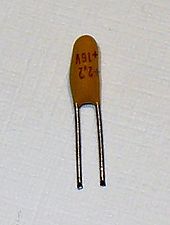
The major use for tantalum, as the metal powder, is in the production of electronic components, mainly
Alloys
Tantalum is also used to produce a variety of alloys that have high melting points, strength, and ductility. Alloyed with other metals, it is also used in making carbide tools for metalworking equipment and in the production of superalloys for jet engine components, chemical process equipment, nuclear reactors, missile parts, heat exchangers, tanks, and vessels.[64][63][65] Because of its ductility, tantalum can be drawn into fine wires or filaments, which are used for evaporating metals such as aluminium. Since it resists attack by body fluids and is nonirritating, tantalum is widely used in making surgical instruments and implants. For example, porous tantalum coatings are used in the construction of orthopedic implants due to tantalum's ability to form a direct bond to hard tissue.[66]
Tantalum is inert against most acids except
Other uses
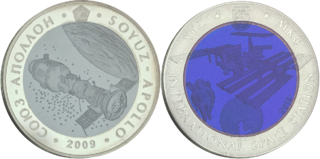
Tantalum was used by NASA to shield components of spacecraft, such as Voyager 1 and Voyager 2, from radiation.[68] The high melting point and oxidation resistance led to the use of the metal in the production of vacuum furnace parts. Tantalum is extremely inert and is therefore formed into a variety of corrosion resistant parts, such as thermowells, valve bodies, and tantalum fasteners. Due to its high density, shaped charge and explosively formed penetrator liners have been constructed from tantalum.[69] Tantalum greatly increases the armor penetration capabilities of a shaped charge due to its high density and high melting point.[70][71]
It is also occasionally used in precious
Environmental issues
Tantalum receives far less attention in the environmental field than it does in other geosciences. Upper Crust Concentration (UCC) and the Nb/Ta ratio in the upper crust and in minerals are available because these measurements are useful as a geochemical tool.[76] The latest value for upper crust concentration is 0.92 ppm, and the Nb/Ta(w/w) ratio stands at 12.7.[77]
Little data is available on tantalum concentrations in the different environmental compartments, especially in natural waters where reliable estimates of ‘dissolved’ tantalum concentrations in seawater and freshwaters have not even been produced.[78] Some values on dissolved concentrations in oceans have been published, but they are contradictory. Values in freshwaters fare little better, but, in all cases, they are probably below 1 ng L−1, since ‘dissolved’ concentrations in natural waters are well below most current analytical capabilities.[79] Analysis requires pre-concentration procedures that, for the moment, do not give consistent results. And in any case, tantalum appears to be present in natural waters mostly as particulate matter rather than dissolved.[78]
Values for concentrations in soils, bed sediments and atmospheric aerosols are easier to come by.[78] Values in soils are close to 1 ppm and thus to UCC values. This indicates detrital origin. For atmospheric aerosols the values available are scattered and limited. When tantalum enrichment is observed, it is probably due to loss of more water-soluble elements in aerosols in the clouds.[80]
Pollution linked to human use of the element has not been detected.[81] Tantalum appears to be a very conservative element in biogeochemical terms, but its cycling and reactivity are still not fully understood.
Precautions
Compounds containing tantalum are rarely encountered in the laboratory. The metal is highly
People can be exposed to tantalum in the workplace by breathing it in, skin contact, or eye contact. The
References
- ^ "Standard Atomic Weights: Tantalum". CIAAW. 2005.
- ISSN 1365-3075.
- ^ ISBN 978-1-62708-155-9.
- ISBN 0-8493-0486-5.
- ISBN 0-8493-0464-4.
- .
- ^ Euripides, Orestes
- PMID 37166044.
- .
- ^ "European Commission (2010). Critical Raw Materials for the EU. Report of the Ad-hoc Working Group on Defining Critical Raw Materials". European Commission. Apr 29, 2015.
- ^ Ekeberg, Anders (1802). "Of the Properties of the Earth Yttria, compared with those of Glucine; of Fossils, in which the first of these Earths in contained; and of the Discovery of a metallic Nature (Tantalium)". Journal of Natural Philosophy, Chemistry, and the Arts. 3: 251–255.
- ^ Ekeberg, Anders (1802). "Uplysning om Ytterjorden egenskaper, i synnerhet i aemforelse med Berylljorden:om de Fossilier, havari förstnemnde jord innehales, samt om en ny uptäckt kropp af metallik natur". Kungliga Svenska Vetenskapsakademiens Handlingar. 23: 68–83.
- S2CID 144857368.
- S2CID 110567235.
- .
- .
- ^ S2CID 97246260.
- ^ ISBN 978-0-8493-6071-8.
- ^ Marignac, M. C. (1866). "Recherches sur les combinaisons du niobium". Annales de Chimie et de Physique (in French). 4 (8): 7–75.
- .
- ^ "Niobium". Universidade de Coimbra. Archived from the original on 2007-12-10. Retrieved 2008-09-05.
- S2CID 28155048.
- ^ Lempriere, John (1887). Lempriere's Classical Dictionary. p. 659.
- ISBN 978-0-08-037941-8.
- ISBN 978-0-86516-573-1.
- S2CID 54079998.
- .
- PMID 19246206.
- ^ Win, David Tin; Al Masum, Mohammed (2003). "Weapons of Mass Destruction" (PDF). Assumption University Journal of Technology. 6 (4): 199–219.
- ^ "Tantalum Target Yields – ISAC Yield Database – TRIUMF: Canada's National Laboratory for Particle and Nuclear Physics". mis.triumf.ca.
- ^ ISBN 978-0-444-51604-6. Retrieved 2008-09-02.
- ISSN 0304-386X.
- ISBN 978-0-08-037941-8.
- ^ ISBN 978-3-11-017770-1.
- .
- ^ .
- ISSN 0001-4842.
- .
- ISBN 978-0-19-850340-8.
- ^ "Mines, Minerals and More". Mindat.org.
- ^ "Talison Tantalum eyes mid-2011 Wodgina restart 2010-06-09". Reuters. 2010-06-09. Archived from the original on 2011-01-19. Retrieved 2010-08-27.
- ^ Emery, Kate (24 Jan 2012). "GAM closes Wodgina tantalum mine". The West Australian. Archived from the original on 4 December 2012. Retrieved 20 March 2012.
Worldwide softening tantalum demand and delays in receiving Governmental approval for installation of necessary crushing equipment are among contributing factors in this decision
- ^ "Wodgina Operations". Global Advanced Metals. 2008. Archived from the original on 2016-10-06. Retrieved 2011-03-28.
- ^ a b Papp, John F. (2006). "2006 Minerals Yearbook Nb & Ta". US Geological Survey. Retrieved 2008-06-03.
- ^ Bleiwas, Donald I.; Papp, John F.; Yager, Thomas R. (2015). "Shift in Global Tantalum Mine Production, 2000–2014" (PDF). U.S. Geological Survey.
- ^ M. J. (November 2007). "Tantalum supplement" (PDF). Mining Journal. Archived from the original (PDF) on 2008-09-10. Retrieved 2008-06-03.
- ^ "International tantalum resources – exploration and mining" (PDF). GSWA Mineral Resources Bulletin. 22 (10). Archived from the original (PDF) on 2007-09-26.
- ^ Tantalum-Niobium International Study Center: Coltan Archived 2016-01-14 at the Wayback Machine Retrieved 2008-01-27
- ^ "S/2003/1027". 2003-10-26. Retrieved 2008-04-19.
- ^ "Special Report: Congo". International Rescue Committee. Archived from the original on 2012-03-05. Retrieved 2008-04-19.
- )
- ^ Dizolele, Mvemba Phezo (January 6, 2011). "Congo's Bloody Coltan". Pulitzer Center on Crisis Reporting. Retrieved 2009-08-08.
- ^ "Congo War and the Role of Coltan". Archived from the original on 2009-07-13. Retrieved 2009-08-08.
- ^ "Coltan mining in the Congo River Basin". Archived from the original on 2009-03-30. Retrieved 2009-08-08.
- ^ United States Geological Survey (January 2021). "USGS Mineral Commodities Summary: Tantalum" (PDF). Retrieved 2021-04-22.
- ^ "Mineral Resources Program". minerals.usgs.gov. Archived from the original on June 4, 2013.
- ^ .
- ISBN 9780080529028.
- S2CID 98753880.
- ^ "Manufacturing metals: A tantalising prospect". The Economist. 2013-02-16. Retrieved 2013-04-17.
- ^ "NFPA 484 – Standard for Combustible Metals, Metal Powders, and Metal Dusts – 2002 Edition" (PDF). National Fire Protection Association. NFPA. 2002-08-13. Retrieved 2016-02-12.
- ^ a b "Commodity Report 2008: Tantalum" (PDF). United States Geological Survey. Retrieved 2008-10-24.
- ^ "Tantalum Products: Tantalum Sheet & Plate | Admat Inc". Admat Inc. Archived from the original on 2018-08-29. Retrieved 2018-08-28.
- S2CID 136550744.
- PMID 17077337.
- ^ .
- ISBN 978-0-525-95432-3.
- .
- S2CID 92307431.
- ISBN 978-0-471-64952-6.
- ^ PMID 20321780.
- PMID 10172264.
- PMID 23162141.
- ISBN 978-0-8247-7309-0.
- .
- .
- ^ .
- .
- .
- PMID 28525874.
- PMID 11336297.
- ^ "CDC – NIOSH Pocket Guide to Chemical Hazards – Tantalum (metal and oxide dust, as Ta)". www.cdc.gov. Retrieved 2015-11-24.
